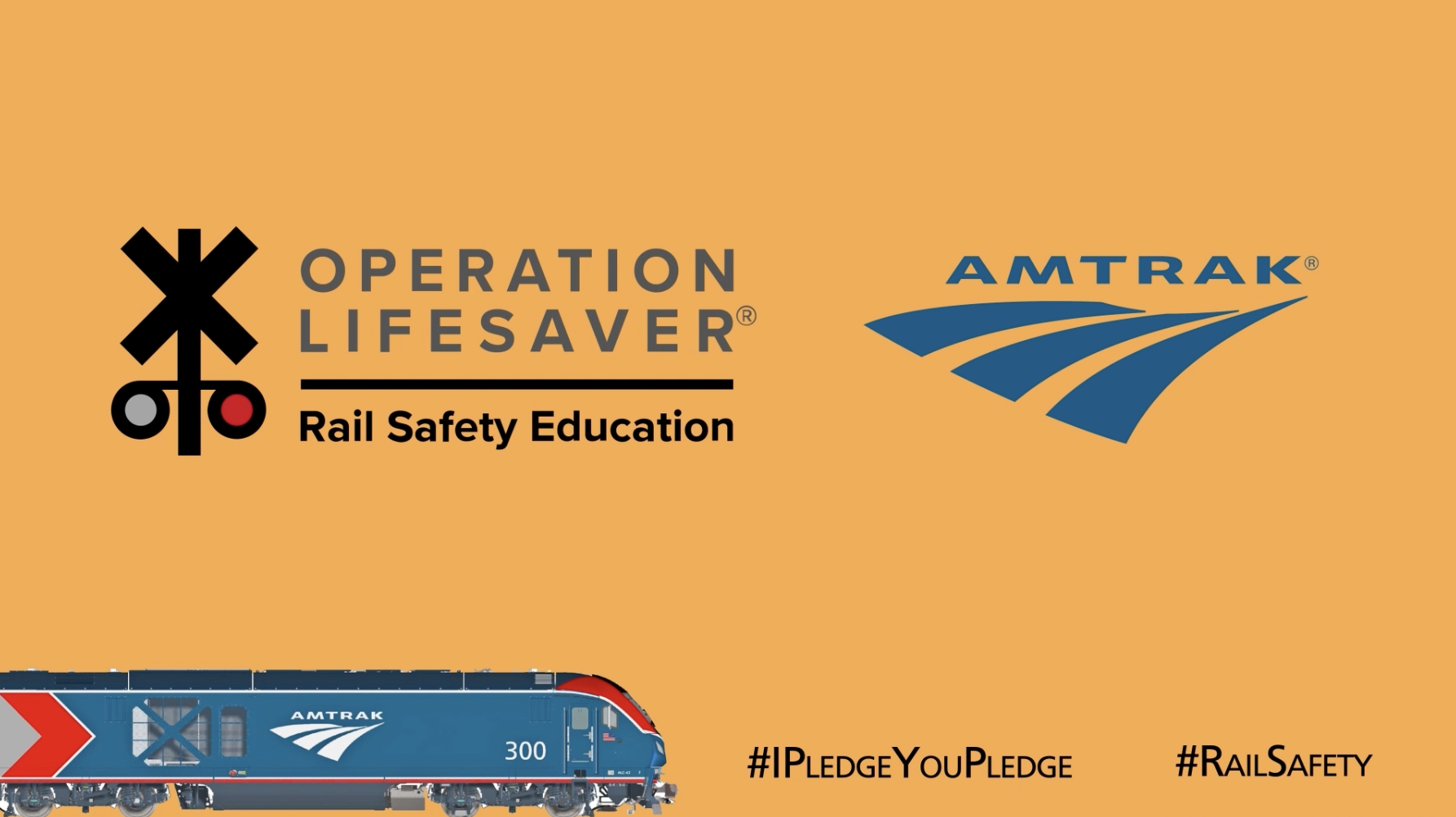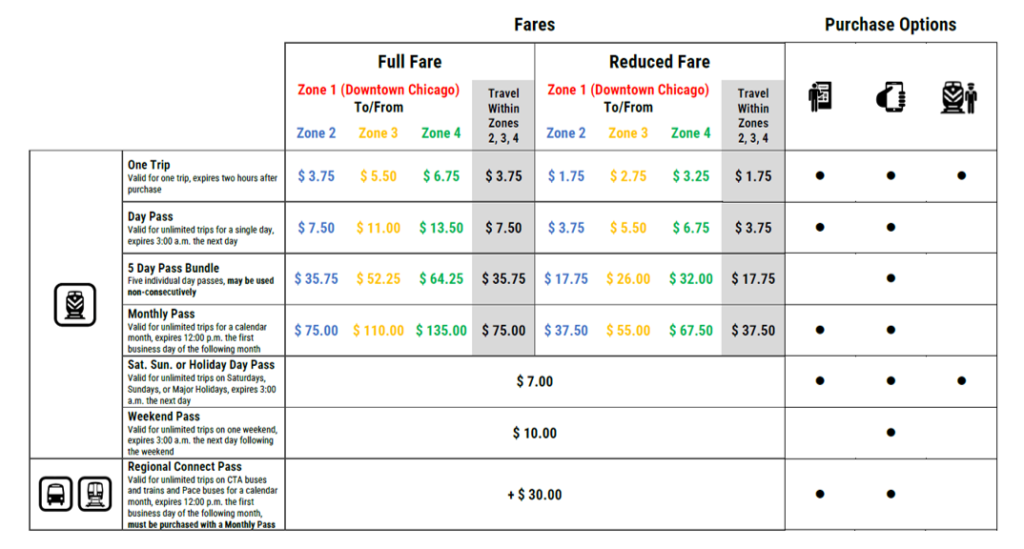
Transit Briefs: Amtrak, NYMTA, Metra, SEPTA, LA Metro, Caltrain
Written by Carolina Worrell, Senior Editor
Amtrak leadership signs Operation Lifesaver, Inc. (OLI) Safety Pledge. Also, the New York Metropolitan Transportation Authority’s (MTA) Long Island Rail Road (LIRR) and Metro-North Railroad set post-pandemic ridership records; Metra seeks public feedback on proposed simplified fare structure; the Southeastern Pennsylvania Transportation Authority (SEPTA) receives two sustainability awards for environmental excellence; LA Metro implements fare capping; and Caltrain delays fare increases.
Amtrak
In honor of National Safety Month, Amtrak recently announced that all 11 members of its executive leadership team have signed the OLI Rail Safety Pledge, challenging others to take the pledge and commit to staying safe near railroad tracks and trains.
Those who take the Rail Safety Pledge can use the share button to post on social media. Using the hashtags #IPledgeYouPledge and #RailSafety, Amtrak encourages others to make their own commitment to saving lives:
- I will make safe choices around railroad tracks and trains by obeying warning signs and always expecting a train.
- I will stay off the tracks including when taking photographs or filming videos and will never walk on or too close to railroad tracks (it’s dangerous and illegal).
- I will only walk, ride or drive across railroad tracks at designated crossings.
- I will share the rail safety message with my friends and family.
According to Amtrak, every three hours in the U.S., a person or vehicle is hit by a train. “Making the right choices can save lives while railroads continue the vital business of delivering goods and people,” the railroad said.
“While we show up every day to deliver a safe experience for our customers, employees and communities, we can only do so much as individuals,” said Amtrak Executive Vice President and Chief Safety Officer Steve Predmore. “Rail Safety is a team effort. As we continue to grow, the best resource to address track incidents is to come together as one.”
According to the Federal Railroad Administration (FRA), trespassing along railroad rights-of-way is the leading cause of rail-related deaths in America, and railroad crossing incidents are the second leading cause. Every time someone trespasses on the tracks, it can lead to devastating results that impact someone’s life, their family, and the community at large.
Amtrak says it continues to work closely with OLI to #STOPTrackTragedies by emphasizing the dangers of being on rail property or disregarding warnings at crossings.
Watch Amtrak’s Executive Leadership Team commit to rail safety below:
NYMTA
The New York MTA on June 21 announced that LIRR and Metro-North Railroad each set post-pandemic ridership records on Tuesday, June 20, with the LIRR carrying 235,806 riders and Metro-North 224,371.
According to MTA, the record day for LIRR followed its busiest week since the start of the pandemic, carrying 1.37 million riders for the week, including past ridership record days June 13 and June 14.
Metro-North had similar momentum leading up to its record day on June 20, in which the railroad carried 224,371 riders. The June 20 ridership record was a 4.5% improvement on Metro-North’s previous pandemic era record of 214,621, set on May 23, 2023, an increase of nearly 10,000 riders. Leading up to this record, Metro-North had its second-best week in the last year, with 1.20 million riders last week.
“The railroads are heading into the summer on ridership highs, which is a vote of confidence from our customers,” said Metro-North Railroad President and LIRR Interim President Catherine Rinaldi. “Whether it’s more people returning to the office, trying to catch a baseball game after work, or heading to hundreds of other destinations throughout the region, people are choosing the railroad to get there.”
Since Grand Central Madison opened for full service on Feb. 27, 2023, the LIRR has carried at least 200,000 riders on 54 weekdays, according to the agency. Metro-North hit the 200,000-rider mark in a single day for the first time since the pandemic on May 11, 2023. Since then, Metro-North has carried at least 200,000 riders 15 additional times.
Metra
Metra announced June 21 that it is asking customers and the public to comment on the biggest proposed change to its fare structure in its history—a plan for 2024 that would reduce the number of fare zones to four from 10 and change some of the fare options available.
The intent of the proposal, Metra says, is to create a fare structure that customers can “easily understand, encourage ridership, simplify onboard fare collection, and meet the agency’s financial and technical constraints.” The effort, Metra says, conforms with goals in the agency’s newly adopted strategic plan, including “enhancing service to grow ridership, ensuring the riding experience is safe, easy and enjoyable, and innovating to become more efficient and effective.”
Metra’s current fare zone system has 10 zones, and prices for some tickets are based on the number of zones traveled. Under the new proposal, there would be only four fare zones (see proposed zone map below). Downtown stations would be assigned to Zone 1 and outlying stations would be assigned to Zones 2 through 4 based on a combination of distance from downtown, service patterns and ridership characteristics on each line, which vary. Generally, stations within and near Chicago would be in Zone 2, stations in an intermediate service zone would be in Zone 3, and remaining stations would be in Zone 4.
Under the proposed new fare structure (see proposed fare chart below):
- One-Way Tickets to the downtown zone, Zone 1, would cost $3.75 from Zone 2, $5.50 from Zone 3 and $6.75 from Zone 4. The new one-way fare from all zones would be equal to or lower than the current one-way fare. To encourage non-downtown trips, all One-Way Tickets for trips that do not include downtown as a starting point or destination would cost $3.75, no matter the distance.
- A Day Pass priced at twice the cost of a One-Way Ticket would be valid for unlimited rides for a single day within the zones selected. The current $6- and $10-Day Passes, introduced as promotional fares during the pandemic, would be discontinued.
- A Bundle of Five-Day Passes would replace the 10-Ride Ticket. The bundle would be priced at 9.5 times the cost of a One-Way Ticket and would only be available via the Ventra app. The passes could be used on non-consecutive days.
- A Monthly Pass would be priced at 20 times the cost of a One-Way Ticket: $75 for Zone 2, $110 for Zone 3 and $135 for Zone 4. This pricing is below the cost of pre-COVID Monthly Passes. The current $100 flat-rate “Super Saver” Monthly Pass, which was introduced as a promotional fare during the pandemic, would be discontinued.
- Metra would no longer allow riders to pay “incremental fares”—a surcharge to travel beyond the zones indicated on their ticket. Instead, riders would be required to buy a ticket valid for the trip they are taking.
- Reduced fares of roughly 50 percent for seniors, K-12 students and active-duty military personnel would be available for One-Way, Day Pass, Day Pass Bundle and Monthly tickets.

The following fare products and prices would not change:
- Metra would continue to sell the $30 Regional Connect Pass to Monthly Pass buyers for unlimited rides on CTA and Pace.
- Metra would continue to sell a $7 Saturday, Sunday, or Holiday Day Pass. A $10 Weekend Pass still would be available on the Ventra app only.
“As we continue to recover from the pandemic, we have an opportunity and a responsibility to change how we do business and create a better Metra for our customers,” said Metra CEO/Executive Director Jim Derwinski. “A system that is easier to use will draw new riders and further cement Metra as the best transportation alternative—the safest, most affordable and most reliable.”
More details about this proposal and how to provide feedback are available here. Feedback can be sent to [email protected].
SEPTA
SEPTA announced June 21 that the agency was the recipient of two prestigious awards for its sustainability efforts—the Pennsylvania Governor’s Award for Environmental Excellence and the IDC Smart Cities Award for Sustainable Infrastructure.
Both awards were in recognition of the Elk Hill 1 and 2 solar farms in Franklin County, Pa., a partnership between SEPTA and utility-scale solar energy project leader Lightsource bp.
According to SEPTA, the electricity generated from Elk Hill 1 & 2 add up to 42 MW of clean, renewable energy, and represents 20% of the agency’s annual electricity demand, which powers facilities, trains and trolleys that currently operate on electricity. This highly successful project locked in energy pricing in 2019 and provides SEPTA with long-term, affordable energy to support the Authority’s operations and has generated almost $1 million in revenue in 2022.
Generation from solar farms of this size and type are expected to reduce greenhouse gas (GHG) emissions by nearly 50,000 metric tons of CO2 annually, according to SEPTA. They also support Pennsylvania’s goals to generate a percentage of clean electricity by solar photovoltaics, helping to “diversify the state’s energy portfolio and increase security with locally generated power.”
“One of the notable benefits of this project was the realization that investing in renewables makes good business sense,” said SEPTA CEO and General Manager Leslie S. Richards. “SEPTA is proud to be an industry leader in utilizing new technologies that are reducing greenhouse gas emissions and enhancing the quality of life for our customers and the communities we serve.” “One of the main goals of our strategic business plan, SEPTA Forward, is to enhance sustainability and expand our access to renewable energy sources. We have taken a major step forward with these solar farms, and we look forward to launching more innovative projects and partnerships.”
The Governor’s Award was presented by the Pennsylvania Department of Environmental Protection on April 25 in Harrisburg, Pa., acknowledging the best in environmental innovation and expertise throughout the Commonwealth. In the category of “Sustainable Infrastructure,” the IDC Smart Cities award was presented in Denver, Co., on May 17, recognizing outstanding Smart Cities projects in North American municipalities.
LA Metro
LA Metro recently announced that starting July 1, the agency will implement fare capping, a new fare policy where riders pay per ride with a TAP card until they reach their one-day fare cap of $5 or their seven-day fare cap of $18, after which they ride free for the remainder of the day or seven-day period.
The fare capping policy, which Metro says will provide “much-needed economic relief to Los Angeles residents,” and has undergone extensive evaluation and analysis, was approved by the Metro Board of Directors last December and aims to ensure Metro fares are “simple, equitable, and affordable for customers so that all riders with a TAP card can earn free rides.”
Before fare capping, customers could save per ride by buying weekly or monthly passes that required riders to pay large sums up front, which was a burden on lower income residents, Metro says. With fare capping, riders load Stored Value (money) on their TAP card and pay as they go. The more customers use Metro, the more money they will save.
“It’s the goal of the Metro Board to help make things as easy as possible for all Metro riders, and fare capping is a big boon for Angelenos and the city overall,” said Glendale City Councilmember and Metro Board Chair Ara J. Najarian. “The cost of transit should never stand between L.A. County residents and opportunity—and this new fare policy will make our systems more affordable, accessible, and appealing for every Angeleno.”
Once customers reach the one-day or seven-day fare cap, they will not have to pay additional fares for the rest of the day or seven-day period. The new policy will make all Metro passes, including the one-day, seven-day or 30-day passes, unnecessary, so they will be eliminated, making the fare structure simpler for customers to use.
Base fares for regular riders will remain at $1.75, while students in grades K-12 will see their base fare drop from $1 to $0.75 cents, and college and vocational students will see their base fare drop from $1.75 to $0.75 cents to match the fare discount offered to seniors and disabled persons. All rides on TAP include two hours of one-way free transfers. Student fares will be capped at $2.50 per day and $6 over a seven-day period. The base fare for seniors and customers with disabilities will remain at $0.75 cents during peak hours and $0.35 cents during off-peak hours. Their daily cap will remain at $2.50, and the seven-day cap will be $5.
“Fare capping will save many of our riders money and give them more flexibility,” said Metro CEO Stephanie Wiggins. “At a time when Los Angeles residents are paying more for everyday items, Metro is helping them save money on transportation, the second largest household expense on average. This is one of several new initiatives we’ve established to lower transportation costs for riders to make our system more accessible and equitable.”
This past March, the Metro Board approved extending the “successful and popular” GoPass pilot program to June 2024, which gives free transit passes to K-12 and community college students at more than 100 participating county schools and school districts. Students have generated more than 16.6 million boardings on the Metro system since the program began in October 2021, averaging 1.2 million monthly. Fare capping will not affect students who use GoPass.
Metro also launched an improved Low-Income Fare is Easy (LIFE) program in late 2021, which offers 20 free rides a month and deeply discounted fares to low-income riders on Metro and 13 other local transit providers. More than 230,000 L.A. County residents have signed up for the LIFE program, and Metro has delivered more than 16 million discounted rides under the program since late 2021. LIFE riders will continue to benefit from their 20-ride free product. Once the 20 free rides are used, to ride on Metro, customers will load Stored Value onto their TAP cards and pay per ride until they reach a one-day or seven-day fare cap.
Metro has launched an awareness campaign promoting the discounts available on TAP and convenient reloading locations. TAP has also increased the number of vendors who sell and reload TAP cards in grocery stores, such as Northgate Ria, El Super, Numero Uno Markets and Superior Grocers. Free TAP cards loaded with $5 of Stored Value are also being distributed at high cash-paying bus stops to increase accessibility and encourage TAP use.
Caltrain
Caltrain announced June 21 that it has extended the 20% Caltrain monthly pass discount through Dec. 31, 2023, to “encourage more riders to return to the system.”
In 2022, Caltrain adopted an updated Fare Structure that included a schedule of fare increases and changes. Two of those fare increases, a 50-cent base fare increase and an increase of the Monthly Pass Trip Multiplier from 24 trips to 30, were planned to go into effect July 1, 2023. However, Caltrain Executive Director Michelle Bouchard has implemented a promotional fare discount that will keep fares at their current levels until Dec. 31, 2023.
Many transit agencies around the country, Caltrain says, are making similar decisions, including the San Francisco Municipal Transportation Authority (SFMTA), the Santa Clara Valley Transportation Authority (SCVTA), the New York MTA, the Massachusetts Bay Transportation Authority (MBTA) and NJ Transit.
Caltrain says it will continue to “assess the situation to inform future decisions about any fare or service changes.” According to the agency, Caltrain continues to run its highest ever service levels of 104 trains per weekday, including enhanced off-peak service.
According to a San Francisco Examiner report, like its peer agencies around the Bay Area and across the state, Caltrain faces a “deeply uncertain financial future after federal COVID-19 relief funds ran out and amid state lawmakers’ budget negotiations that could significantly cut public transit spending.
“Caltrain said in April its projected deficit in the 2026 fiscal year is $33 million, followed by $57 million in the next one.
“The rail line’s ridership also lags behind other transit agencies in the region. In April, Caltrain’s average weekday ridership (18,621) was 27.7% of February 2020 levels (67,218) and 27.4% of the April 2019 average (68,000).”



